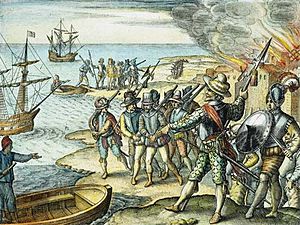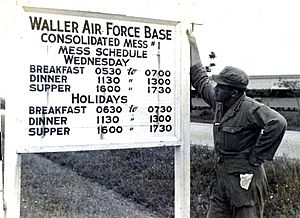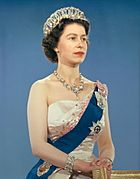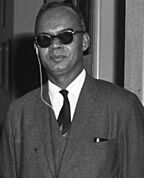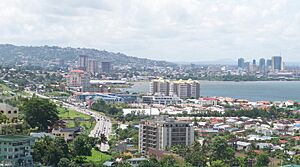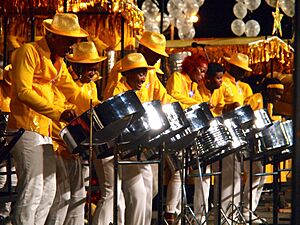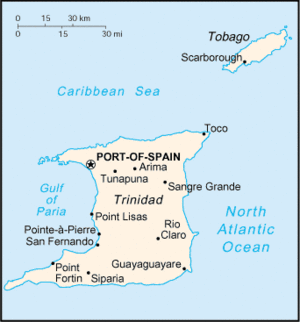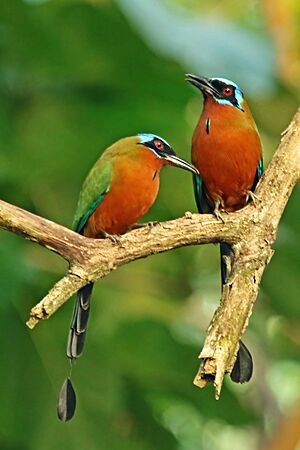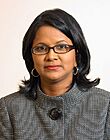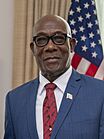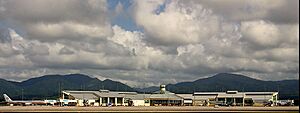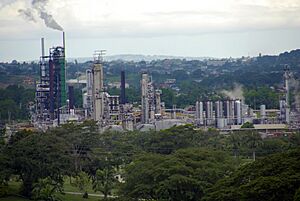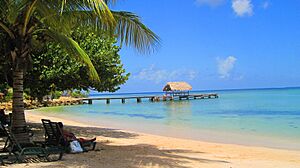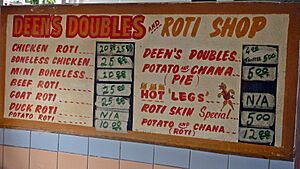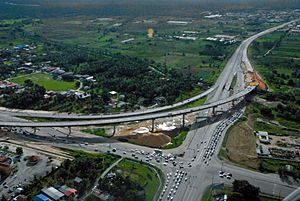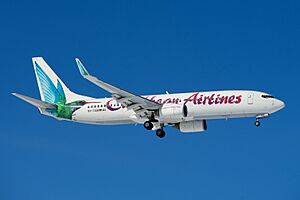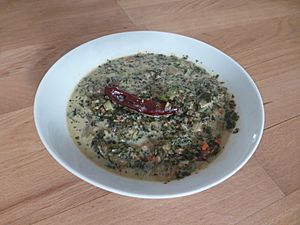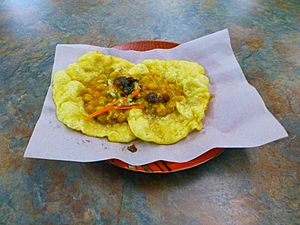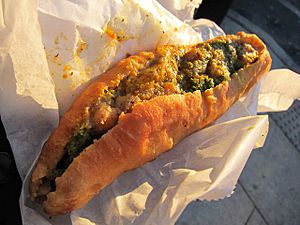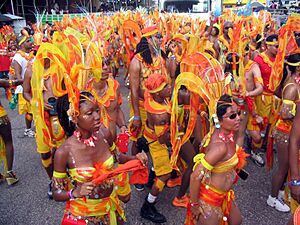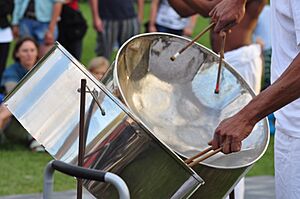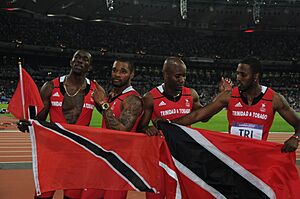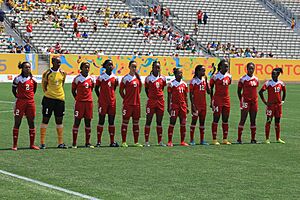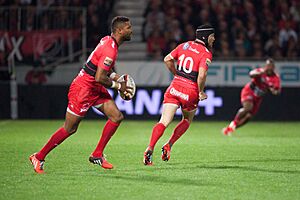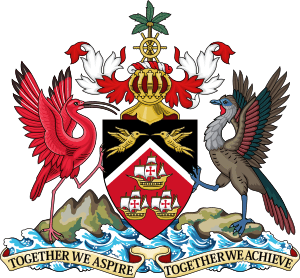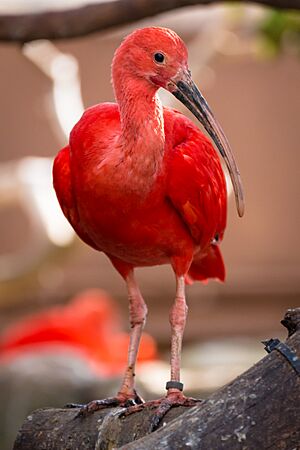Trinidad and Tobago facts for kids
Quick facts for kids
Republic of Trinidad and Tobago
|
|
|---|---|
|
|
|
|
Motto: "Together we aspire, together we achieve"
|
|
|
Anthem: "Forged from the Love of Liberty"
|
|
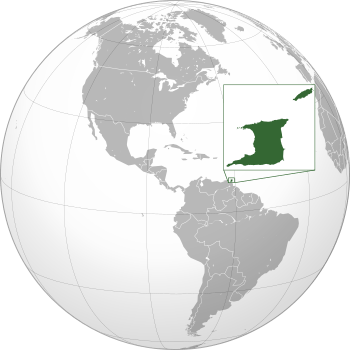 |
|
| Capital | Port of Spain 10°40′01″N 61°30′27″W / 10.667°N 61.5075°W |
| Largest city | Chaguanas 10°31′N 61°24′W / 10.517°N 61.400°W |
| Official languages | English |
| Other languages | See Languages in Trinidad and Tobago |
| Ethnic groups
(2011)
|
|
| Religion
(2020 est.)
|
|
| Demonym(s) |
|
| Government | Unitary parliamentary republic |
| Christine Kangaloo | |
| Kamla Persad-Bissessar | |
|
• House Speaker
|
Bridgid Annisette-George |
| Legislature | Parliament |
| Senate | |
| House of Representatives | |
| Independence
from the United Kingdom
|
|
|
• Province of the West Indies Federation
|
3 January 1958 – 14 January 1962 |
| 31 August 1962 | |
|
• Joined the Caribbean Community at the Treaty of Chaguaramas
|
1 August 1973 |
|
• Republic
|
1 August 1976 |
| Area | |
|
• Total
|
5,131 km2 (1,981 sq mi) (164th) |
|
• Water (%)
|
negligible |
| Population | |
|
• 2024 estimate
|
1,508,635 (154th) |
|
• Density
|
294/km2 (761.5/sq mi) (34th) |
| GDP (PPP) | 2023 estimate |
|
• Total
|
|
|
• Per capita
|
|
| GDP (nominal) | 2023 estimate |
|
• Total
|
|
|
• Per capita
|
|
| Gini (2012) | 39.0 medium |
| HDI (2022) | very high · 60th |
| Currency | Trinidad and Tobago dollar (TTD) |
| Time zone | UTC-4 (AST) |
| Date format | dd/mm/yyyy |
| Driving side | left |
| Calling code | +1 (868) |
| ISO 3166 code | TT |
| Internet TLD | .tt |
Trinidad and Tobago, officially the Republic of Trinidad and Tobago, is an island country in the southern Caribbean. It is made up of two main islands, Trinidad and Tobago, plus many smaller islands. This country is located just 11 kilometers (7 miles) off the coast of northeastern Venezuela. It is also about 130 kilometers (81 miles) south of Grenada.
Trinidad and Tobago is considered part of the West Indies. Its capital city is Port of Spain, and its largest city is Chaguanas.
The island of Trinidad was home to native people for many centuries. Then, Christopher Columbus arrived in 1498, and it became a Spanish colony. In 1797, the British took control of Trinidad. Both Trinidad and Tobago were given to Britain in 1802. They became one country in 1889. Trinidad and Tobago gained its independence in 1962 and became a republic in 1976.
Unlike most Caribbean nations, Trinidad and Tobago's economy mainly relies on industry. It has large amounts of oil and natural gas. This makes the country very wealthy.
Trinidad and Tobago is famous for its mix of African and Indian cultures. This can be seen in its big and lively Carnival, Diwali, and Hosay celebrations. It is also the birthplace of the steelpan instrument, the limbo dance, and music styles like calypso and soca. The country is located far south, so it gets fewer hurricanes than most other Caribbean islands.
Contents
History
Early People and European Arrivals
The islands of Trinidad and Tobago were first settled by native people from South America. Trinidad was settled over 7,000 years ago. This makes it the oldest settled part of the Caribbean. The oldest known site is Banwari Trace in southwest Trinidad, dating back to about 5000 BC.
When Europeans arrived, Trinidad was home to Arawakan-speaking groups like the Nepoya. Tobago was home to the Island Caribs.
Christopher Columbus was the first European to see Trinidad in 1498. He also saw Tobago from far away but did not land there.
In the 1530s, a Spanish soldier named Antonio de Sedeño tried to conquer Trinidad. He fought the native people and built a fort. In 1592, a native chief named Wannawanare gave land near modern Saint Joseph to the Spanish. The town of San José de Oruña was founded there. Soon after, in 1595, the English sailor Sir Walter Raleigh attacked San José while looking for the legendary "El Dorado" (City of Gold).
Meanwhile, many European countries tried to settle Tobago in the 1600s. The Dutch, English, and Couronians (from Latvia) all tried. From 1654, the Dutch and Courlanders, joined by French settlers, gained a stronger hold. They started plantations to grow sugar, indigo, and rum. Many African slaves were brought to work on these plantations. Tobago changed hands 31 times between France, the Netherlands, and Britain before 1814.
In Trinidad, the Spanish struggled to control the native people. In 1689, native people in the San Rafael area rebelled and killed some priests and the Spanish governor. The Spanish fought back, and many native people died. Over time, diseases brought by Europeans also greatly reduced the native population.
Trinidad was a quiet Spanish province for a long time. The capital moved to Puerto de España (now Port of Spain) in 1757. The Spanish did not try hard to settle the islands. By 1777, Trinidad only had about 1,400 people.
French Settlers Arrive
In 1783, the Spanish king offered free land and tax breaks to Roman Catholic settlers. This was to encourage more people to move to Trinidad. Many French planters, their slaves, and free people of color came from nearby islands like Martinique and Grenada. They started farms for sugar and cocoa.
This led to a big increase in Trinidad's population. By 1797, Port of Spain had grown from under 3,000 to over 10,000 people. The total population of Trinidad was 17,718. This included Europeans, free people of color, enslaved people, and native people.
British Rule Begins
In 1797, a British force led by General Ralph Abercromby invaded Trinidad. The Spanish governor surrendered without a fight. Trinidad became a British colony. British rule was made official in 1802.
More settlers came from the United Kingdom and other British colonies. This included English, Scottish, Irish, German, and Italian families. Some free Black people, called "Merikins", who fought for Britain in the War of 1812, were given land in southern Trinidad.
Slavery was ended in 1833. After this, former slaves had an "apprenticeship" period. In 1838, all enslaved people were fully freed. At that time, Trinidad had about 17,439 enslaved people. This was much fewer than other islands like Jamaica, which had around 360,000.
Indian Workers Arrive
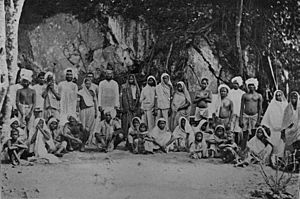
After slavery ended, many former slaves did not want to work on plantations anymore. They moved to towns. This caused a shortage of workers for farms. So, the British brought in workers from other countries under a system called "indentureship." These workers included people from India, China, and Portugal.
Most of these workers came from India. The first ship with 225 Indian workers arrived in Trinidad on May 1, 1845. Indian indentureship lasted until 1917. During this time, over 147,000 Indians came to Trinidad to work on sugarcane farms.
These contracts were sometimes unfair. Workers were paid, and their contracts ended after a set time. But they were often forced to stay longer. After their contracts, about 90% of Indian immigrants chose to stay in Trinidad. They were also required to carry passes if they left the plantations.
Few Indians settled on Tobago. People of African descent continued to be the majority there. In the late 1800s, Tobago faced economic problems. In 1876, there were riots on a plantation. As a result, Tobago became a British Crown colony in 1877. Because the sugar industry was failing, Britain joined Tobago with Trinidad in 1889.
Early 1900s and Independence
In 1903, a protest in Port of Spain over new water rates turned into a riot. 18 people died, and the government building was damaged. A local assembly with some power was created in 1913. Trinidad and Tobago remained mostly a farming colony, growing sugarcane and cocoa.
In 1919, dockworkers went on strike for better pay. Other workers joined, leading to a general strike. This was one of the first times different ethnic groups worked together.
In the 1920s, the sugar and cocoa industries struggled. This led to poverty and the rise of a labor movement. Conditions worsened in the 1930s during the Great Depression. There were labor riots in 1937. Leaders like Arthur Andrew Cipriani and Tubal Uriah Butler pushed for workers' rights and more self-rule from Britain.
Oil was discovered in 1857, but it became important in the 1930s. By the 1950s, oil was a main export for Trinidad. This helped create a growing middle class.
During World War II, American military bases in Trinidad improved roads and offered jobs. However, the presence of soldiers also caused some problems. The Americans left in 1961.
After the war, Britain began to let its colonies become independent. In 1945, all adults in Trinidad and Tobago could vote. Political parties formed, often along ethnic lines. The People's National Movement (PNM), led by Eric Williams, was supported by Afro-Trinidadians. The People's Democratic Party (PDP), later part of the Democratic Labour Party (DLP), was supported by Indo-Trinidadians.
The British Caribbean colonies tried to form the West Indies Federation in 1958 to gain independence together. But the Federation broke up in 1961 when Jamaica left. So, Trinidad and Tobago decided to seek independence on its own.
Modern Times
Trinidad and Tobago became independent from the United Kingdom on August 31, 1962. Elizabeth II remained the head of state until 1976. Then, Trinidad and Tobago became a republic.
Eric Williams became the first Prime Minister. He served until 1981. In the 1960s, a Black Power movement grew, inspired by the civil rights movement in the United States. There were protests and strikes. In 1970, Prime Minister Williams declared a state of emergency. Some army leaders tried to rebel, but this was stopped.
In 1963, Hurricane Flora hit Tobago, causing much damage. Because of this, tourism became more important than farming for Tobago's economy. In 1973, Trinidad and Tobago became a founding member of the Caribbean Community (CARICOM). This group helps Caribbean countries work together on economic and political matters.
From 1972 to 1983, the country benefited from rising oil prices. This led to an economic boom and better living standards. In 1976, the country became a republic within the Commonwealth. The role of governor-general was replaced by a President. Ellis Clarke was the first President. In 1980, Tobago gained some self-rule with the Tobago House of Assembly.
When Eric Williams died in 1981, George Chambers became Prime Minister. By this time, oil prices fell, causing an economic slowdown. In 1986, A. N. R. Robinson became Prime Minister. His economic changes led to social problems. In 1990, a group called the Jamaat al Muslimeen took over the Parliament building and the TV station. They held the government hostage for six days.
Patrick Manning became Prime Minister in 1991. The economy improved. In 1995, Basdeo Panday became the first Prime Minister of Indian descent. After some political changes, Patrick Manning returned to power in 2001 and served until 2010.
In 2003, the country had another oil boom. Oil, gas, and chemicals are still the main parts of the economy. Tourism is important for Tobago. In 2010, Kamla Persad-Bissessar became the country's first female prime minister. In 2015, Keith Rowley became Prime Minister. His party won the general election again in 2020.
Geography
Trinidad and Tobago is located in the southeastern Caribbean. It is just 11 kilometers (7 miles) from Venezuela in South America. The islands are actually a natural extension of the South American continent.
The country covers an area of 5,128 square kilometers (1,980 square miles). It has two main islands, Trinidad and Tobago. They are separated by a 37-kilometer (23-mile) strait. There are also many smaller islands.
Trinidad is much larger, covering 4,768 square kilometers (1,841 square miles). It is about 80 kilometers (50 miles) long and 59 kilometers (37 miles) wide. Tobago is about 300 square kilometers (116 square miles). It is 41 kilometers (25 miles) long and 12 kilometers (7.5 miles) wide.
The islands have mountains and plains. In Trinidad, the Northern Range runs along the north coast. It has the country's highest peak, El Cerro del Aripo, which is 940 meters (3,084 feet) high. The rest of Trinidad is mostly flat. There are also the Central Range and Southern Range hills. The east coast has famous beaches like Manzanilla Beach. Trinidad also has large swamp areas.
A unique feature of Trinidad is Pitch Lake. It is the world's largest natural deposit of asphalt.
Tobago has a flat plain in the southwest. The eastern half is more mountainous, with Pigeon Peak as its highest point at 550 meters (1,804 feet). Tobago also has several coral reefs.
Most people live on Trinidad. The main cities are Port of Spain (the capital), San Fernando, Arima, and Chaguanas. The main town on Tobago is Scarborough.
Climate
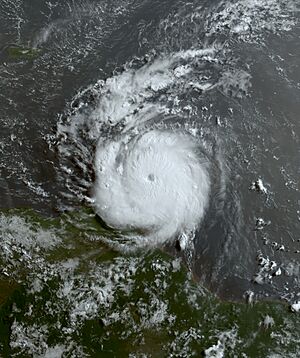
Trinidad and Tobago has a warm, tropical climate. There are two seasons: a dry season for the first five months of the year and a rainy season for the remaining seven. Winds mostly come from the northeast.
Unlike many Caribbean islands, Trinidad and Tobago is usually safe from hurricanes. However, Tobago was hit by Hurricane Flora in 1963. In the Northern Range of Trinidad, the climate is often cooler due to clouds, mist, and heavy rains.
The highest recorded temperature in Port of Spain is 39°C (102°F). The lowest is 12°C (54°F).
Biodiversity: Plants and Animals
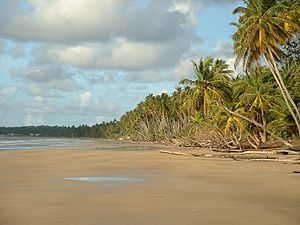
Trinidad and Tobago's plants and animals are very diverse. This is because the islands were once connected to the South American mainland. Their wildlife is more like Venezuela's than other Caribbean islands.
The main natural areas include:
- Coastal and marine areas (coral reefs, mangrove swamps).
- Forests.
- Freshwater areas (rivers and streams).
The country has many animal species:
- 472 bird species (2 found only here).
- About 100 mammals.
- About 90 reptiles.
- About 30 amphibians.
- 50 freshwater fish and at least 950 marine fish.
Some notable mammals are the ocelot, West Indian manatee, and red howler monkey. There are also about 70 types of bat. Large reptiles include 5 types of sea turtles that nest on the beaches. There are also green anacondas and Boa constrictors. Of the 47 snake species, only four are venomous, and they are only found in Trinidad.
Marine life is rich with sea urchins, corals, lobsters, dolphins, and whale sharks.

Trinidad and Tobago is famous for its many bird species. It is a popular place for bird watchers. Famous birds include the scarlet ibis, cocrico, and 17 types of hummingbird.
There are about 3,300 plant species, with 59 found only here. Forests still cover about 40% of the country. There are about 350 different types of trees. One special tree is the manchineel, which is very poisonous to humans.
Threats to the country's wildlife include too much hunting, loss of natural areas, water pollution, and new species that harm local ones.
Government and Politics
Trinidad and Tobago is a republic with a parliamentary system. This system is based on the Westminster System used in the United Kingdom.
The head of state is the President. This role is mostly ceremonial. The President is chosen by members of Parliament.
The head of government is the Prime Minister. After a general election, which happens every five years, the President chooses the person who has the most support in the House of Representatives to be Prime Minister.
Since 1980, Tobago has its own elections. Its members serve in the Tobago House of Assembly.
The Parliament has two parts:
- The Senate (31 members).
- The House of Representatives (41 members).
Senators are appointed by the President. Some are chosen by the Prime Minister, some by the leader of the opposition, and some are independent. The 41 members of the House of Representatives are elected by the people.
Administrative Divisions
Trinidad is divided into 14 local areas. These include nine regions and five municipalities. They have some self-governing powers. Elections for these councils are held every three years. Tobago is managed by the Tobago House of Assembly.
Demographics
The population of Trinidad and Tobago is estimated to be between 1.4 and 1.5 million people in the mid-2020s.
Ethnic Groups
The people of Trinidad and Tobago come from many different backgrounds. The two largest groups are those of Indian and African heritage.
- Indo-Trinidadian and Tobagonians make up about 35.4% of the population. They are mostly descendants of workers who came from India. Many still keep traditions from their homeland. Most Indo-Trinidadians live on Trinidad.
- Afro-Trinidadians and Tobagonians make up about 34.2% of the population. Most are descendants of enslaved people brought from Africa. This group is the majority on Tobago, making up 85.2% of its population.
The rest of the population is mostly of mixed heritage. There are also smaller groups of native people, Europeans, Chinese, and Arabs.
Arima in Trinidad is an important center for the culture of the First Peoples.
Languages
English is the official language. Other languages spoken on the islands include Trinidadian Creole English, Tobagonian Creole English, Caribbean Hindustani (a dialect of Hindi), Spanish, and Chinese.
Religion
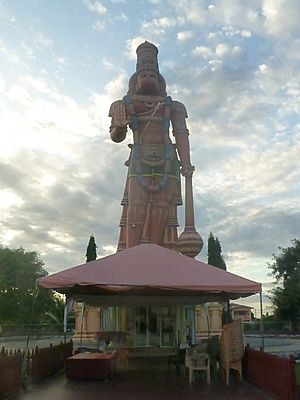
Christianity is the largest religion, followed by 55.2% of the population in 2011. Roman Catholics are the largest Christian group.
Hinduism is the second largest religion, followed by 18.2% of the population. Diwali is a public holiday, and other Hindu holidays are celebrated. Most Hindus in Trinidad and Tobago follow the Sanatan Dharma Maha Sabha.
Muslims make up about 5% of the population. Eid al-Fitr is a public holiday, and other Muslim holidays are also celebrated.
African-based religions like Trinidad Orisha and Rastafari are also practiced.
A small Jewish community has existed for centuries.
About 11% of people did not state a religion, and 2% said they had no religion.
African syncretic faiths, like the Spiritual Baptists and the Orisha faith, are growing fast. There is also a rise in Evangelical Protestant churches.
Education
Children usually start pre-school at two and a half years old. They are expected to have basic reading and writing skills for primary school. Primary school starts at age five and lasts seven years. After primary school, students take an exam to decide which secondary school they will attend.
Secondary school lasts at least five years. Students take the CSEC (Caribbean Secondary Education Certificate) exams. These are like the British GCSE O levels. Students with good grades can continue for two more years to take the Caribbean Advanced Proficiency Examinations (CAPE), which are like GCE A levels.
Public primary and secondary education is free. Private and religious schools are also available for a fee.
The government helps pay for university education up to a bachelor's degree. This is through a program called GATE. It covers studies at the University of the West Indies (UWI) and other local schools. The government also gives scholarships for talented or needy students.
Economy
Trinidad and Tobago is the most developed and one of the wealthiest nations in the Caribbean. It is among the top 40 high-income countries in the world. Its income per person is one of the highest in the Caribbean.
Trinidad's economy is strongly linked to the petroleum industry. Tourism and manufacturing are also important. Tourism is growing, especially on Tobago. The country also makes goods like food, drinks, and cement for the Caribbean region.
Oil and Gas
Trinidad and Tobago is the top producer of oil and gas in the Caribbean. Its economy relies heavily on these resources. Oil and gas make up about 40% of the country's total economic output and 80% of its exports. However, they only provide 5% of jobs.
Recent growth has come from investments in liquefied natural gas (LNG) and chemicals. The country is a major exporter of LNG. Its biggest markets are Chile and the United States.
Trinidad and Tobago has shifted from an oil-based economy to one based on natural gas. Oil production has decreased over the last ten years.
Tourism
Trinidad and Tobago depends less on tourism than many other Caribbean countries. Most tourist activity happens on Tobago. The government has been trying to increase tourism in recent years.
The islands are known for their street food and cultural events. Aripita Avenue in Port of Spain is a popular spot for this.
Agriculture
In the past, farming was the main part of the economy. Sugarcane was the most important crop. It brought in the most money and provided many jobs. Most of it was sold to other countries. Cocoa was the second most valuable crop.
However, farming has greatly declined since the 1900s. It now makes up a very small part of the country's economy. Various fruits and vegetables are still grown, and fishing is common.
Food and Beverage Industry
Trinidad and Tobago is home to the largest brewery company in the Caribbean, the Carib Brewery. It also has many food production factories. The country tends to import food because it has less land and a higher income. But it still produces milk, chocolate, coconuts, and alcoholic drinks.
Doubles is a very famous street food. It consists of two fried flatbreads with curried chickpeas and various sauces. It is popular as a late-night snack or breakfast. Aloo pie is another popular street food. Aloo means potato in Hindi. It is a baked pastry filled with spicy mashed potatoes and chickpeas.
Other popular foods include Callaloo, Pelau, and Roti. Fresh coconut water, rum, and Mauby are popular drinks.
Creative Industries
The government sees creative industries as a way to grow the economy. In 2015, the Trinidad and Tobago Creative Industries Company Limited (CreativeTT) was set up. Its job is to help the music, film, and fashion industries grow and export their work.
Transport
Trinidad and Tobago has a good transport system. There are many highways and roads on both main islands. Ferries connect Port of Spain with Scarborough and San Fernando. Both islands have international airports.
Public transport includes buses, taxis, and minibuses. By sea, there are inter-island ferries and water taxis.
Piarco International Airport serves Trinidad. It opened in 1931. It is the seventh busiest airport in the Caribbean. Caribbean Airlines, the national airline, has its main base here. It flies to the Caribbean, North America, and South America.
Tobago is served by the A.N.R. Robinson International Airport. It has regular flights to North America and Europe. There are also regular flights between Trinidad and Tobago.
Trinidad used to have a railway network, but it closed in 1968. There have been talks about building a new railway.
Culture
Trinidad and Tobago has a rich and varied culture. It has influences from African, Indian, European, Chinese, and other communities. This mix comes from the many people who have moved to the islands over time.
Steelpan music, the limbo dance, and Carnival with its colorful costumes are famous parts of the culture. Caribbean street foods are also very popular.
Art and Design
Peter Minshall, a designer from Trinidad, is known for his Carnival costumes. He also helped design the opening ceremonies for the Olympic Games and FIFA World Cup. He won an Emmy Award for his work.
Cuisine
The food in Trinidad and Tobago also shows its diverse influences. It has African, Indian, and colonial traditions. Street food is very popular. Some examples are Doubles, Aloo pie, and Bake and shark.
Main dishes include curry crab with dumpling, Pelau, and Trinidadian Callaloo. Desserts include Pone and Kurma.
Doubles is one of the most famous foods. It has two fried flatbreads with curried chickpeas and different sauces. It is believed to have been invented in Trinidad in 1936. Aloo pie is another popular street food. Aloo means potato in Hindi. It is a baked pastry filled with spicy mashed potatoes and chickpeas.
Fresh coconut water, rum, and Mauby are popular drinks.
Dance
The limbo dance started in Trinidad. It was made popular in the 1950s by dancer Julia Edwards. The limbo dance has African roots. Other dances with African roots include Bélé and Bongo.
Jazz, ballroom, ballet, modern, and salsa dancing are also popular.
Indian dance forms are also common. Kathak, Odissi, and Bharatanatyam are popular Indian classical dances. Indian folk dances and Bollywood dances are also enjoyed.
Festivals and Holidays
The island is famous for its yearly Carnival celebrations. Many festivals from different religions and cultures are also popular.
- Hindu festivals include Diwali, Phagwah (Holi), and Nauratri.
- Christian holidays include Spiritual Baptist/Shouter Liberation Day, Easter, and Christmas.
- Muslim holidays include Hosay (Ashura), Eid al-Fitr, and Eid al-Adha.
People of Indian descent celebrate Indian Arrival Day. This day remembers the arrival of their ancestors from India. People of African descent celebrate Emancipation Day. This day remembers when their African ancestors were freed from slavery. Trinidad and Tobago was the first country to make both of these public holidays.
National holidays like Independence Day, Republic Day, and Labour Day are also celebrated.
Literature
Trinidad and Tobago has two Nobel Prize-winning authors: Vidiadhar Surajprasad Naipaul and Derek Walcott (who was born in St. Lucia). Other important writers include Michael Anthony and Samuel Selvon.
Music

Trinidad and Tobago is the birthplace of calypso music and the steelpan instrument. It is also where soca music, chutney music, and other music styles like parang and rapso began.
Media and Theatre
Geoffrey Holder and Heather Headley are two Trinidad-born artists who have won Tony Awards for theatre. Heather Headley also won a Grammy Award.
Indian theatre is also popular. Plays about Hindu deities like Rama and Krishna are performed.
Trinidad and Tobago is the smallest country to have two Miss Universe winners. Janelle Commissiong won in 1977, and Wendy Fitzwilliam won in 1998. The country also had one Miss World winner, Giselle LaRonde, in 1986.
Sports
Olympic Sports
Hasely Crawford won Trinidad and Tobago's first Olympic gold medal in the men's 100-meter dash in 1976. Nine different athletes from Trinidad and Tobago have won twelve Olympic medals.
Keshorn Walcott won a gold medal in the men's javelin throw in 2012. This made him the second Trinidadian to win gold and the first to win a field event gold. Ato Boldon has won the most Olympic and World Championship medals in athletics for the country.
In 2018, Trinidad and Tobago was awarded the gold medal for the 4x100 relay at the 2008 Olympics. This happened after another team was disqualified.
In 2023, Trinidad and Tobago hosted the 2023 Commonwealth Youth Games. In 2024, about 17 athletes from Trinidad and Tobago competed in the Paris Olympics.
Cricket
Cricket is a very popular sport in Trinidad and Tobago. It is often called the national sport. The country is part of the West Indies cricket team. The national team also plays in regional competitions.
The Queen's Park Oval in Port of Spain is the largest cricket ground in the West Indies. Trinidad and Tobago helped host the 2007 Cricket World Cup.
Brian Lara, a famous cricketer, was born in Trinidad. He holds world records for the most runs scored in Test and First Class matches.
Football
Football (soccer) is also popular. The men's national team qualified for the 2006 FIFA World Cup for the first time. They were the second smallest country by population to qualify. They drew one game but were eliminated after losing two others.
Trinidad and Tobago hosted the 2001 FIFA U-17 World Championship and the 2010 FIFA U-17 Women's World Cup. The TT Pro League is the country's main professional football league.
Basketball
Basketball is played in colleges and universities. The national team is one of the most successful in the Caribbean. It won four gold medals in the Caribbean Basketball Championship from 1986 to 1990.
Other Sports
Netball used to be very popular. The country co-won the Netball World Championships in 1979. Rugby and horse racing are also popular.
There is a national baseball team. There are also several golf courses on the islands.
Bodybuilding is growing in interest. Darrem Charles, a former world-class bodybuilder, is from Trinidad and Tobago.
Dragonboat racing has also grown quickly since 2006. Claude Noel, a former world champion boxer, was born in Tobago. The Trinidad and Tobago Chess Championship started in 1937.
National Symbols
Flag
The flag was chosen in 1962. Red, black, and white represent the warmth of the people, the richness of the earth, and water.
Coat of Arms
The coat of arms was also designed by the Independence committee. It features the scarlet ibis (native to Trinidad), the cocrico (native to Tobago), and a hummingbird. The shield has three ships, representing both the Trinity and Columbus's three ships.
National Anthem and Songs
The national anthem is "Forged from the Love of Liberty". Other national songs include "God Bless Our Nation" and "Our Nation's Dawning".
National Flower
The national flower is the chaconia flower. It was chosen because it is native to the islands. It also has the same red color as the flag and blooms around Independence Day.
National Birds
The national birds are the scarlet ibis and the cocrico. The scarlet ibis is protected in the Caroni Bird Sanctuary. The cocrico is more common on Tobago. The hummingbird is also an important symbol.
Related Pages
- List of rivers of Trinidad and Tobago
- Trinidad and Tobago at the Olympics
- Trinidad and Tobago national football team
See also
 In Spanish: Trinidad y Tobago para niños
In Spanish: Trinidad y Tobago para niños




